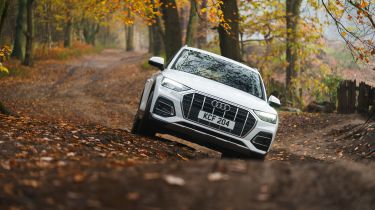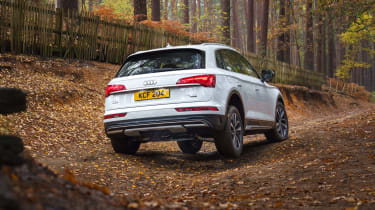Audi Q5 review - Engines, drive & performance
"Driving the latest Audi Q5 reveals how much difference a decade of development can make"
Making a tall SUV like the Audi Q5 drive like a normal hatchback or saloon car usually means fitting stiff suspension, as doing so minimises the extra body lean the additional height and weight would otherwise provoke when cornering.
The previous version of the Audi Q5 is an excellent example of this – although it was easy and predictable to drive, its firm suspension meant that it could be genuinely uncomfortable over rough and bumpy roads, transmitting lumps and ruts to the cabin in a way that didn’t match its family car aspirations. The latest Q5, though, is fast, easy to drive and – crucially – absorbs pitted tarmac effectively yet barely leans when cornering. This is even more the case if you go for the optional adaptive air suspension.
The Q5’s steering is accurate enough and makes the car easy to place on the road, but it gives you little information about what the front wheels are doing or how much grip they have. We found selecting ‘Dynamic’ mode on Audi’s Drive Mode Selector sharpened up its responses somewhat, but it also makes the ride too firm. Handily, the ‘Individual’ mode lets you pick and mix between the settings to suit your personal preferences. Currently, every Q5 comes with a dual-clutch automatic gearbox and a four-wheel-drive system that disengages the rear wheels when cruising to save fuel.
Enthusiasts will favour the SQ5, reviewed separately, which has a lower ride height than the standard Q5, sportier handling and loads of grip. It still manages to be refined and comfortable, although as it’s a diesel it’ll still need semi-regular long journeys to stay in optimum condition.
More reviews
As was the case with the previous Q5, if you’re after an SUV of this size and driver involvement is important to you, the BMW X3 and Jaguar F-Pace both feel more dynamic in corners.
Audi Q5 petrol engine
We’re familiar with Audi’s 261bhp 2.0-litre 45 TFSI engine from the A4 and other models, and it’s a peach. It’s smooth and, as four-wheel drive is fitted as standard in the Q5, capable of getting up to speed very quickly. It feels like something much more powerful in Sport mode, and a 6.1-second 0-62mph time is on a par with lighter hot hatchbacks. Dialling it back to Comfort or Eco subdues the acceleration to the point where it feels like the car’s on a lead.
Diesel engines
Nice as the petrol may be, it'll cost more to run than the more fuel-efficient diesel. Like the petrol, we’ve experienced this diesel in numerous other models from Audi, Volkswagen and more, but that’s no bad thing. The 201bhp 2.0-litre 40 TDI is punchy enough and gets the Q5 from 0-62mph in 7.6 seconds. Using a 336bhp 3.0-litre diesel, the range-topping SQ5 takes just 5.1 seconds to reach 62mph from a standstill. It’s not quite as quick as the petrol-powered Volkswagen Tiguan R and may prove more expensive, but its day-to-day running costs will be slightly more palatable.
Hybrid engine
There’s now just one version of the plug-in hybrid, badged 50 TFSI e with 295bhp – the 362bhp 55 TFSI e model was discontinued in mid-2022. It feels smooth to drive in EV mode, with enough power to cruise at motorway speeds, even if high speeds will drain the battery more quickly. Hybrid mode uses the navigation to work out when best to use each power source for the most efficiency, and the changes between them are almost imperceptible.
Which Is Best?
Cheapest
- Name2.0 TFSI Quattro Sport 5dr S Tronic
- Gearbox typeSemi-auto
- RRP£50,580
Most Economical
- Name2.0 TDI Quattro Sport 5dr S Tronic
- Gearbox typeSemi-auto
- RRP£52,230
Fastest
- NameSQ5 TFSI Quattro Launch Edition 5dr S Tronic
- Gearbox typeSemi-auto
- RRP£76,030














